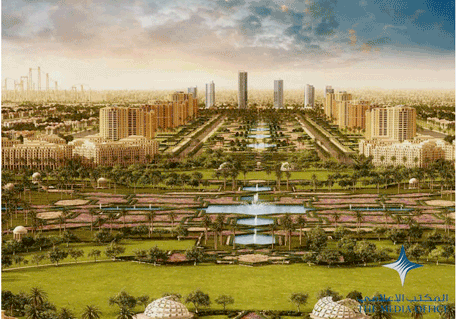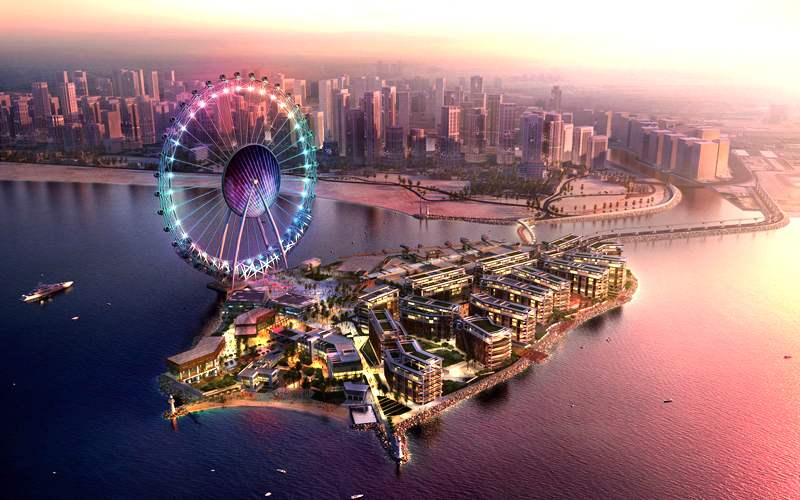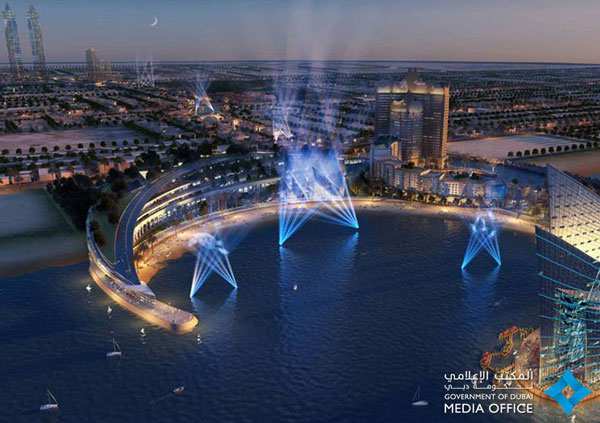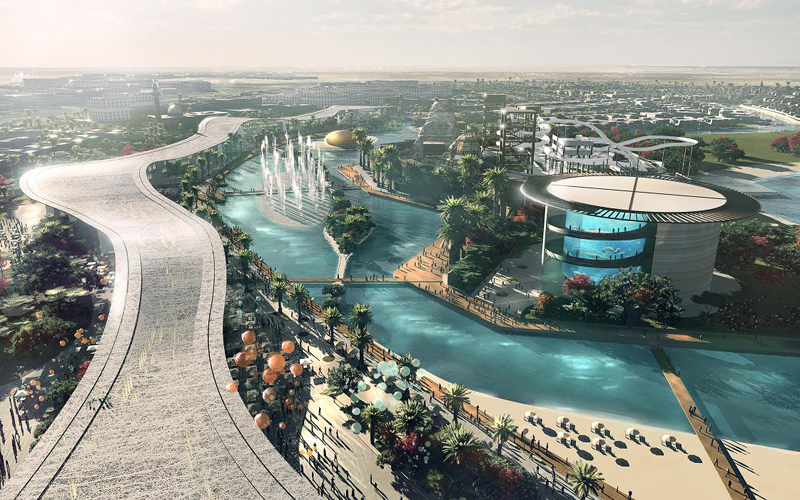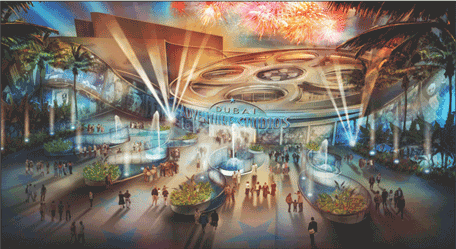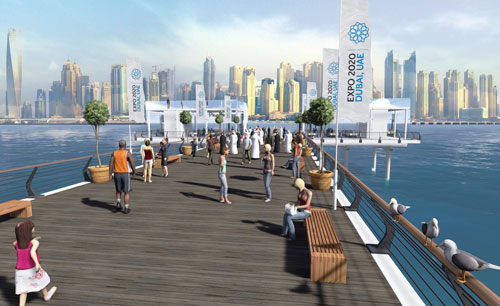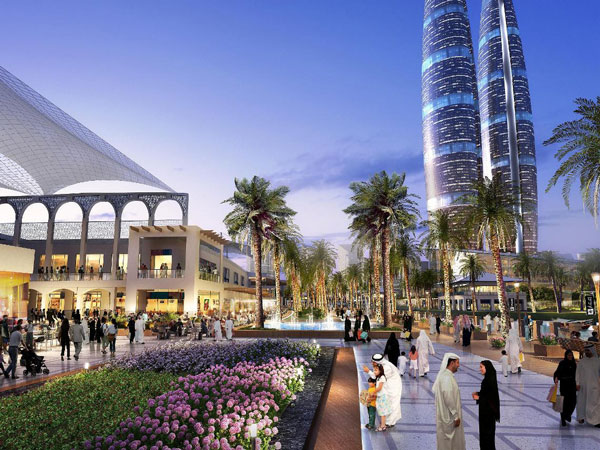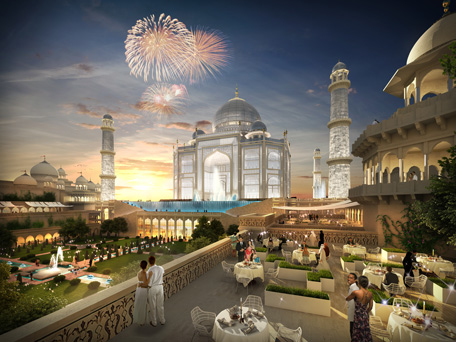BAHRAIN
WORLD TRADE CENTRE
Abstract
This case study is about the Bahrain World Trade Center.
This explains how it was designed, constructed, the problems faced, how those
problems were overcome, and why this building is special from the others. The
reason why this topic was chosen for the case study was because this building
is unique from other buildings not because of its beauty, but because of its
green technology. Also, this project takes an exceptional place in stainable
technology. Taking all these factors into consideration, the topic “Bahrain
World Trade Centre” was chosen.
Introduction
The Bahrain world trade centre which is located in Manama,
which has two 50-storey sail shaped towers, which is having a height of 240m
and contains three 29m diameter horizontal axis wind turbines. The towers are
placed on top of a three story podium,
which accommodates a new 9600m^2 shopping Centre, fine hotels, food
centers, business Centre, health club spa, and 1800 onsite parking spaces. But
what makes this unique is not its height or beauty but its green technology. Bahrain world trade center was designed by the
south African architect Shaun Killa who is a specialist in using sustainable
design buildings.
DESIGN
Background
The
designing and the architecture was completely done by the great architecture
Shaun Killa. A person who is ready to show the concept that Bahrain is not only
interested in fossil fuels it is more towards sustainability. Designing this
structure that is creating massive wind turbines in a building structure is not
an easy task and if it was successful there is a lot of benefits from this
project, and the knowledge of this technology can be shared worldwide
Unique design features of this building
The unique feature of this building is that the electricity
is provided for the entire building using the three wind turbines which is fixed
to the building. The turbine uses the wind energy to make its wings rotate and
convert that energy into electrical energy. So to make this project successful
they overcame a lot of problems.
The shape of the
building
The basic design of this building was taken from sail boats.
The building is designed in such such a way as shown in figure 1.1, so that the
air is channeled between the two buildings using the principals of air flow,
funneling the onshore winds between them and creating a negative pressure zone
behind, so that it accelerates the wind velocity between the towers into the
path of the turbines. The towers tapered shape with higher wind speeds at
increasing height means that the three fixed turbines have a nearly constant
vertical velocity profile. Within a 45 angle both sides of the central axis,
the center of the wind stream is perpendicular to the turbines.
Figure 1.1. The shape of the building
Design of wind
turbines angle and problems faced
The building is being installed with three wind turbines to
generate electricity. Basically the wind turbines are pole mounted and it is
facing the direction where the wind increases the odds of maximum energy. It
looks easy to imagine but when it is applied practically it is really hard,
because Bahrain has variable direction wind climates.
Most of the architectural studies regarding building-integrated,
horizontal axis turbines follow the principle of a fixed turbine as in the case
of this tower. Fixing vertical axis wind turbines to the towers are always
encouraged and everyone gets a lot of advantages from it for being sustainable
and low cost. Out of all the design development of this project has proved that
using vertical axis turbines will not be available especially for building
purposes.
Fixing a
horizontal turbine has some problems like it can only be able to operate with
wind from a limited angle. If problems faced with blade deflections and stressing
or straining through excess air flow are to be avoided. Since the building has been designed in such
a way where the wind can be directed towards the wind turbine the problem can
be resolved.
Wind tunnel
modeling that was validated by CFD models. Have shown that the incoming wind will
get deflected by the two towers and have an s shaped streamline flow as shown
if figure 1.2 where the wind speed can be tolerated by the wind turbine.
Engineers have predicted that the turbine can operate for the wind directions
from the angle of 270 and 360. But still prevention measures have been taken
and the angle has been reduced to 285 and 345. The wind turbine has an ability
to automatically adapt to a standby mode when the wind comes from outside the
give range angle. It is now clear that it was not a co incidence that the
buildings are extremely have high power to prevail against wind.
Figure 1.2. The streamline
flow of wind towards the building
The wind turbines which is fixed on this project contains the
following contents, Nacelle: which contains enclosure with gearbox, generator, cooling
system and associated control systems, Rotor, Bridge, Control,
monitoring and safety systems, Electrical Building Interface.
Nacelle and Rotor
The nacelle is
the term used for the cowling containing the gearbox, brake, controls, etc. and
in addition, there is the rotor.
Table 1.1. Components used
and their performances
|
Nominal
electrical power generated
|
225kw
|
|
Power
regulation
|
stall
|
|
Rotor diameter
|
29m
|
|
Rotor speed at
full load
|
38rpm
|
|
Air brake
|
Centrifugally
activated feathering tips
|
|
Maximium wind
speed for blades
|
80m/s (any
direction)
|
|
High speed
mechanical brake
|
Fail safe type
disc brake
|
|
Low speed
mechanical brake
|
Caliper type
|
|
Generator
|
Closed 4 pole
asynchronous induction 50Hz
|
|
Yaw system
|
Fixed yaw
|
|
Cut in wind
speed
|
4m/s
|
|
Cut out wind
speed
|
20m/s (5minute
rolling average)
|
The machine of
the turbine is designed to fixed on the top rather than into the bridge so that
it is easy to provide its functions easily to the turbine. The designed turbine
is simple and reliable it can be controlled easily. Then the turbine rotor
blades are bolted into the hub and then it is fixed in the desired angle to
make sure that it makes the maximum use of the wind. The wind creates
turbulence on the front side of the blade hence the power output will always be
the maximum output.
The maximum power
which is about 225W will be reached when the speed is at 15 to 20m/s but it
might change according to the wind density and other factors. When there is
conditions like high speed wind, the wind turbine which is operating or in
standby mode the tip of it extends by the centrifugal force and then it rotates
to act as it has self-working brake and exerts drag force and finally it makes
the turbine stop.
Bridges
The main parts of
this unique design is the loads on the rotor, through the nacelle and then onto
the key part of the design, such as bridges and the tower. Hence the structure should be analyzed for
strength and other properties. Calculations regarding the load and all for this
project have been made by the bridge designers and in conjunction with the wind
turbine manufacturers where they use a specially adopted version to become the
best wind turbine design. This machine which was designed for this purpose has
the ability to take note of the influences of the buildings, bridges and
fans.199 different types of load cases has been applied for creating this model
of turbine and validating calculations or operational processes prepared to
theatrically demonstrate that the turbine and the bridge has the capacity for excessive pressure and load. At the early
stages of construction adjustments were made to theoretical value and
experimental values were considered so that the energy yield could be increased
or decreased.
The bridges have
been designed aerodynamically and the structure is complex as shown in figure
1.3, because it maintains free bearings where they connect to the buildings to
allow the two towers 0.5m relatively. Moreover the bridges which is 317m long
have been designed to support a nacelle with a mass of 11 tones have been
designed to withstand the vibration and vibrations created by the all three
wind turbine. The bridges have been analyzed by the bridge designer to estimate
the natural frequency of the bridge and to ensure it is safe even when it is
having high vibrations due to itself of by the building. Further precautions
have been taken in the design like the bridge has been damped, so that it won’t
be problematic anymore during commissioning. Another precaution taken was
adding spoilers to the bridge and mass damper is tuned and adjusted.
Figure 1.3. Shape of the
bridge
The bridge is
designed in a shallow V shape in an angle of 173 degrees to prevent blade
deflection during extreme conditions and to afford enough clearance and to
prevent blade strikes to the building. Moreover under all these conditions,
blade clearance to the bridge which is 1.12m is achieved. The worst part was
the blade tips was extended giving a factor-ratio of 1.35 safety margin, and
under all these conditions adequate clearance was given to do. Moreover a laser
blade is fixed where it monitors the system that will set the turbine to stand
steady if the deflection becomes excess.
Turbine speed control design
The wind turbine
control system is a quality control system that is specially being designed to
control and monitor functions of the turbine. The design is trustable and
reliable because it is able to shut down turbines safely when there is a huge
change in the climatic condition or due to other factors which will threaten
safety of human life or the building. Moreover the system is designed online so
it can be accessed from anywhere and it can be controlled under the grants of
the appropriate organizations. There is another machine fixed inside the
turbine where it is independent which comes to a standby mode if there is any
real emergency like fire or hurricane etc.
CONSTRUCTION
Planning
As the building
was designed the hardest part begins now that is the construction of it. So
since Shaun Killa proposed the design, the construction started as proposed in
the design, bull dozers started to clear the places and the work began. At the
same time Shaun Killa started to search for the turbine manufactures and bridge
engineers. But the problem he faced was other turbine engineers didn’t share
his visions. They thought it might be dangerous for human life because the
turbine which is in the middle of the tower is inches away from the building so
there are chances for accidents.
However after
reaching six months that is when the building was reaching its fifth floor, two
engineers from Danish respond. Earnest sungill who designs turbines and laas
torback engineers bridges. The two engineers did several experiments with
models and they found the design can be successfully applied and constructed on
the building. But before that they overcame a lot of problems. One of it was
how strong the components need to be, so the engineers took 20 years of wind
data from Bahrain airport and they found how strong it should be hence the
turbines were manufactured.
Materials used during the construction
During
construction a lot of materials were used, and most of them were renewable or
recyclable. Some of the materials which were used are given in table 2.1.all
the materials were bought to the construction site through heavy vehicles like
huge trucks to save time and money.
Table 2.1. Materials used during the
construction
|
Concrete
|
4000cubic meter
|
|
Steel
reinforcement
|
730 tonnes
|
|
Cement
|
1600 tonnes
|
|
Stone and sand
|
7400 tonnes
|
|
Water
|
1600 litre
|
Construction of the building
As according to
the design and the plan the work stated with the foundation. The foundation
used was deep foundation. The main problem the engineers were facing during
construction was building the correct shape as planned and designed. Since the
most sides of the building were curved, it was really hard to achieve that
task. The window glasses was fiber glasses which is really strong enough to
withstand some force.
Figure
2.1. Construction progress
Manufacturing the wind turbines
Once again the
engineers undergo a lot of problems that is manufacturing. For factories it is
really small orders and it was hard to make. But finally they got that done
from a factory from eastern Denmark. This blade is the largest blade ever
constructed. Another problem they faced was installing the bridges as specified
in the design.
Installations of the bridges
After two and a
half years the building construction it finally reaches 240m as designed. Now
the installation of bridges begins. This is most dangerous task they faced in
this project. Each of the bridges were carried up and installed. But the
process was really hard. Each bridge was weighing 68 tones and lifting them up
is act of an absolute precision. Since the bridge is shaped aerodynamic this is
like airplane wings, so hanging on cables makes its sleek shape difficult to
control in high wind. The bridge was carried up at 11m/h. once the bridge is
taken up only one side was bolted and the other side was placed on solid steel
rollers.
Installations of turbine and the
propellers
The next task of
the construction is installing them and the group was given only seven days to
complete the task. But still again a lot of problems was faced. After
installing two generators the wind increases it reaches 50km/h where lifting it
would be risky hence they lost a lot of time but then they installed it when
the wind speed was 32km/h. after the turbines were taken up 18 bolts which is
27mm thick was used to fix the turbines to the bridge. But the strenuous
challenge was raising aerodynamic blades designed to accelerate wind has to be
raised between the two towers. They came across another problem as well there
was storm which was preventing them from carrying up. Basically the three
blades were fixed to the central hub and were ready to be raised. Each blade
contains 50 layers of fiber glass glued together around wood reinforcements. Hence,
it is really hard to control their movement while installing so they used
longer ropes to maintain the balance and to prevent colliding with the
building. Finally the 4.2 tone turbine was raised to the top and bolted, where
the first one is fixed at 61m height. Then all three was installed successfully.
Recommendation
The Bahrain world trade center is showing us that the world
is running out of non-renewable resources. So we should come up with something
where it is renewable, sustainable and cost effective. This is just one of the
examples but the human society will be facing loads of sustainable engineering
wonders very soon.
PROJECT MANAGEMENT
Introduction
Project
management is very important in the construction of a building for it to be
successful. It involves team leadership and coordination, diligent project
planning and effective oversight of the delivery process. This section offers
guidance for the entire team to effectively carry out a high performance
building project since it is critical to satisfy client and end user needs.
Value for the
money in construction requires the completion of a project on time, on budget
and to a level of quality that meets the predetermined needs. Project
management ensures that the project will be well-programmed and will continue
to provide value and meet user needs throughout its lifetime as well as
contribute positively to the environment in which it is located with a wide
range of both social and economic benefits.
Early
investment in planning, programming and design can help deliver these benefits
without unnecessary costs and delays but the responsibility for delivering
high-quality products rests with the entire team.
When the
project is being planned, the whole-life value should be considered not just
initial capital costs. The building should have performing facilities during
its whole lifetime. Hence planning by the client, design and construction teams
can have enormous benefits to the project value and make the job easier.
People Involved:
Table 3.1. People involved
in the construction
|
Engineering
and design consultancy
|
Atkins
|
|
Architect and
Design director
|
Shaun Killa,
Atkins Middle East
|
|
Management
|
Atkins
Ramboll
|
|
Managing
Partner
|
Ole Sangill,
Norwin A/S
|
|
Main
Contractor
|
Norwin A/S
Elsam
Engineering
|
|
Senior
Section Manager
|
Simon Hill, Murray
and Roberts
|
|
Country
Manager and Director of leasing and managing agents
|
Bob Addison
|
|
Project
director
|
Lars Thorbek,
Ramboll Danmark A/S
|
Progress of construction:
Location:
Manama, Bahrain
Total costs:
USD $ 150 millions
Table 3.2. Progress of the
construction
|
Year
construction started
|
2004
|
|
Year
construction ended
|
2008
|
|
Total
duration of construction
|
4 years
|
|
Time taken
for twin towers to reach 5th floor
|
6 months
|
|
Time taken
for twin towers to reach 240m/ 50th floor
|
2.5 years
|
|
Time taken to
install bridges, generators and turbines
|
7 days
|
|
Time taken to
install turbines and blades
|
3 days
|
|
Time taken for building to be completed
|
Approx. 44
months
|
The lowest wind
turbine was tested eight months after it had been installed has while the other two were tested ten months
after they had been installed.
Figure 3.1. The testing of the turbines
Difficulties encountered:
Design stage
Problem 1: The
first difficulty encountered was to figure out where the wind turbines should
go. It was finally decided that they would be part of the building on
horizontal bridges between the two towers stacked on each other but the major
problem was that wind turbines are normally mounted on vertical poles and can
turn to face winds in different directions so that they can receive
uninterrupted wind coming at them so as to send it to a generator which
converts it into energy. The wind turbines of the building would however be on
a horizontal axis fixed into position unable to turn into the changing winds.
Also since wind speed increases with height, the uppermost turbine would rotate
more quickly creating more power while the lowermost one which receives less
wind power will create less power. The three turbines needed to rotate at the
same speed so that one does not wear off before the other.
Figure 3.2. The design of
the turbine on a horizontal bridge
Solution 1: To
counter this, the building was designed in such a way that it resembled the
sails of a boat. This particular shaped would cause the wind to be funneled and
would cause the bottom turbine to rotate more quickly while making the top one
rotate less quickly as well as receive uninterrupted wind flow.
Problem 2: Temperatures
in Bahrain can reach up to 48°C, much heat would be absorbed into the Bahrain
World Trade Center. Hence, maintaining a cool temperature inside the building
would be more costly
Solution 2: the
windows would have to be tinted and double glazed so as to reduce 85% of the
heat which would have otherwise been absorbed into the building.
Construction stage
Problem 1: The
construction was already under way and neither turbine manufacturers nor bridge
engineers were interested in his project since there was the risk of blade
failure and the machine could topple over and if it happened in a commercial
center where there are people inside the building only inches away from the
blade, then the possibility of the getting hurt is possible. All the turbine
manufacturers and power providers were turning down the project. The
construction was still going on past six months and had reached the fifth floor
when a Danish company, Norwin A/S, responded to the offer.
Problem 2:
Blade manufacturers were not interested in this project as they were used to
receiving orders to a large scale and this building only required three wind
turbines and three wind generators. It was then finally decided that a
pre-existing blade model would be used but the safety features would have to be
enhanced since the blades will be spinning above a shopping mall
Problem 3: The
lifting of the bridges was a very difficult task since each one weighed about
68 tonnes, hanging on cables, their particular shape made it difficult to
control in high wind. The crane operators had to lift the bridges slowly at a
speed of only 11 metres per hour. The workers bolted only one side of each
bridge to the tower while the other ends were placed onto solid steel rollers.
Problem 4: On
the day that the first set of blades were to be installed, the wind was blowing
at more than 85km per hour and it was impossible to lift the blades since each
one was strong, flexible and aerodynamic; it would be prone to rotate in the
blowing wind therefore making it difficult to control during its ascent. It was
finally in the afternoon that the speed of the wind finally decreased to about
21km per hour. Ropes were used on each blade by the ground crew while they were
being lifted to prevent them from rotating due to the wind hence ensuring that
the towers the blades did not collide with the tower. It was also a difficult
task to dock the blades to the turbines as the wind was blowing in the opposite
direction hence causing the blades to move away from the bridge. The blades had
to be tied in position to the bridge using ropes and bolted so as to maintain
it in place.
Problem 5:
Ground crew members had much difficulty in controlling the last set of blades as
the wind speed was higher than the cut off speed they had decided and the angle
at which the blades were being lifted was much steeper. They took longer than
planned to complete the installation of the last set of blades.
Figure 3.3. The installation of the third set of
blades
Recommendation
The dimension of the set of blades should have been smaller since the
distance between the blades tip and tower wall was only 3.8 metres. The crew
took a big risk as it was also quite windy on the days that the blades were
being installed causing the probability of collision to be higher. If the
collision had occurred, they would have suffered a big loss.
OCCUPATIONAL HEALTH AND SAFETY
Introduction
Health and safety is of great
importance in the construction industry. Occupational safety and
health (OSH) aims at providing and maintaining a
safe and healthy work environment
to people engaged in work or
employment so that they do no leave their jobs due to a health
problem caused by their working conditions. It
also places workers in a job which is adapted
to their physiological and psychological
capabilities. It may also protect co-workers, family
members,
employers, customers, suppliers, nearby communities, and other members of the
public who are being impacted by the workplace
environment as well as reduce medical care,
sick leave and disability benefit cost.
The main focus in occupational health is on three different objectives:
1. the maintenance and promotion of workers’
health and working capacity
2. the improvement of working environment and
work to become conducive to safety
and health
3. Development of work organizations and
working cultures in a direction which supports health and safety at work and in
doing so also promotes a positive social climate and smooth operation and may
enhance productivity of the undertakings.
Health and safety of
the workers can be increased by looking into the workplace accidents and
safety, safety management and control, maintaining safety and work place
regulations.
Risk management:
Accidents on the construction
site are something which mankind cannot avoid. There is risk in every human
activity. There are many accidents which occur on sites which can result in
serious injuries or even death. If the management team actually takes into
consideration on the safety of the workers, the risk management process should
be carried out so that accidents and injuries at construction sites can be
improved. In order to do so, three steps should be followed
1.
identifying the risk
2.
assessing the risk
3.
choosing an
alternative or a risk treatment method
Table 4.1. Number
of deaths per year for each type of accidents in the world
|
Types of
accidents
|
Approx. deaths
per year
|
|
Construction site
falls
|
300
|
|
Crane accidents
|
140
|
|
Electrical
accidents
|
350
|
|
Fires and
explosions
|
200
|
|
Dangerous
construction equipment
|
1000
|
|
Elevator accidents
|
30
|
|
Forklift accidents
|
100
|
Figure 4.1. Percentage of
deaths worldwide
Precautions taken by workers:
All the workers
were required to wear hard hats, boots and safety vests which are very bright
in color. These safety vests are reflective hence the workers are
noticed easily at night. Those who
were handling the glass panes and machineries wore safety gloves as well as
safety glasses. Workers required to work on the bridges to bolt the turbines
wore a safety harness which was buckled to the bridge. Additionally, workers
working near loud machinery wore ear plugs to protect their ears from ear
damage.
Evacuation processes and emergency exits:
There are
several emergency exits on each floor of the Bahrain World trade center but the
multiple floors of the building creates a problem which is the fact that all
the people have to travel great vertical distances on stairs in order to
evacuate the building. The process of
evacuation in some of the largest high-rise buildings in the world may take up
to almost two hours. This is why an early alarm is given so that the people in
the building can start the evacuation processes. Emergency personnel are trained to know all
the emergency exits so that once they have assessed the degree of danger; they
can then assist the occupants to the emergency exits.
Fire emergency procedure:
The fire and life safety
systems include automatic smoke detectors and fire sprinkler protection which
is designed to control a fire henceforth decreasing the need to evacuate all
occupants. Fire
extinguishers are also placed in each corridor.
The normal fire
evacuation procedures state that the occupants of the fire floor and the floors
immediately above and below it should immediately use the exit stairs to
descend to a floor level that is at least several floors below the fire floor,
and await further instruction from safety officials.
Each
building has a senior official as well as a nominated deputy and each floor has
a fire warden. The fire wardens are responsible for ensuring that the workers
are aware of the location of the fire alarm points. The workers are trained to
know the fire emergency evacuation plan. They also have to ensure the regular
use of the primary and secondary escape routes. Regular drills should be
carried out using varying escape routes assuming the normal evacuation route is
not available. An assembly point should also be determined and a roll call of
workers taken. These assembly points should be far enough from the building so
as to ensure that workers are not in danger of falling debris.
Maintenance of turbines:
The Bahrain World
Trade Centre is equipped with a control system that has been made specifically
to control and monitor the wind turbines. It is robust and reliable and has
control and monitoring functions. It can shut down the turbines in case there
are adverse climatic conditions or due to other factors that will damage the
turbine and generator. It is an on-line system which allows authorised
operators anywhere in the world to gain access to the operating data and hence
control the turbines. It has an in-built independent, emergency, safety
surveillance system which will self-monitor possible faults in the turbine as
well as in the immediate turbine operating environment and will shut down if
necessary. In case of a control system failure, the turbine is forced to
standstill by a power fail – failsafe mechanism. In the event of an outage or
reduction in voltage/frequency
from the board’s power supply the turbines will be shut down.
Security:
The Bahrain world trade Centre has been equipped with very
high security. It has structured cabling
systems which integrate SMART features which encompass all forms of
surveillance, data, energy and other operating systems. It also includes the
latest Closed Circuit Television (CCTV) 24 hour surveillance
and monitoring, automated access for tenants to common areas, parking
facilities and individual floors. There are control rooms on each floor as
well as security guards in charge of each
floors.
Recommendation:
Since the
building has three wind turbines the risk of blade failure is also possible if
there is an earthquake or some other natural disaster. This could also cause
machine and turbines failure and the bridge could topple over. If there are
people inside the building, they could get seriously hurt and it could result
in the death of many people. Instead of using wind turbines, solar panels could
have been used as Bahrain has a mainly
cloudless sky.
SUSTAINABILITY PRACTICES
Introduction
The word ‘sustain’ is mostly described as to ‘maintain’,
‘support’ or ‘endure’. The definition that is generally used for sustainability
and sustainable development is of the
Brundtland Commission of the
United
Nations on March 20, 1987: “sustainable development is
development that meets the needs of the present without compromising the
ability of future generations to meet their own needs.” The Bahrain World Trade
Centre fits the above description quite well as it is one of the buildings in
the world that excels at sustainability.
Atkins
Atkins is the sustainability engineer of the Bahrain WTC. It
is also the civil, mechanical and electrical engineer, while being one of the
architects of the building too. Their community of 650 architects makes them
one of the world’s leading architecture organizations. Architecture is just one
of the services they offer. They have design studios all over the world, for
instance, London, Dubai, Shanghai, and Bangalore. Atkins won the Architect of
the year 2008 award from the Building Design Awards for this project.
Wind power
Figure 5.1. The wind turbines
The Bahrain World Trade Centre is considered an engineering
marvel due to the amazing revolutionary technology that has been used to
construct the building. It uses numerous energy saving methods, but the focal
point is the three wind turbines. Three sky bridges connecting the two
sail-shaped towers support these 29m-diameter turbines. The special shape of
the towers, which is inspired by the Arabian wind towers, helps the towers
channel the sea breeze into the turbines and accelerate the wind velocity
between the two. In order to attain a roughly equal amount of wind velocity,
the upright shaping of the towers gradually diminish the pressure to be
combined with the increasing speed of the onshore wind at growing heights.
Comprehending this miraculous concept was one of the main
factors that led to the success of this design. Excessive amounts of wind
tunnel testing established how the relationship of the shapes and the space of
the towers can shape the airflow into an ‘S’ which guarantees that the centre
of the airstream stays perpendicular to the turbines inside a 45° wind angle
from either side of the central axis. This vividly increases the turbines’
capacity to generate power.
Sustainability of the building is vastly increased by the
wind turbines because between 11% and 15% of the building’s electricity needs
are generated by these turbines which calculates up to 1,100MWh – 1.300MWh a
year. 50% of the time, the turbines function at a windspeed of 15m/s to 20m/s
with full power being produced. The
predicted life span of the three turbines is 20 years and each turbine has a
total output of 225MW. The maintenance requirement by the generators is very
low and they are being controlled by centres located in the towers.
The Bahrain WTC holds the record as the first project to
accomplish large-scale execution of wind turbines in a building. The issue so
far was the high cost of developing the turbines which has a possibility to sum
up to 30% of the cost of the building. But Simha LytheRao Senior Project
Manager for Atkins in Bahrain says, “The use of established technologies,
including type-tested turbines with minimal modifications, ensured that the
additional cost incurred by incorporating turbines into the project was reduced
to around 3.5% of the overall project value, making it not only an
environmentally responsible but also a financially viable venture.” (AFP,
2008)
Environment Considerations
The design of the Bahrain WTC is intelligent and
ecologically responsive. Reduction of solar gain is achieved by incorporating
enough buffer space between air-conditioned spaces and the outside environment.
Solar gain is lessened by the two car park decks above and on the southern side
of the building that decrease solar air temperature. Moreover, kinetic
insulation is provided by the deep gravel roofs.
The air temperature of the building is reduced by the extra
high-quality solar glasses which are used with low-shading coefficient.
Suitable sheltering is provided by the balconies to the slanting elevations
with overhangs. The opaque materials installed in the building are given
heightened thermal insulation.
Atkins have made a link to the district cooling system, a
system which has a mechanism of sea water cooling and heating rejection and is
efficient in converting high-energy, assisting to maintain low carbon
emissions. The Bahrain WTC is cooled by chilled water, and they have built
reflection pools at the entrances of the building which offer local evaporative
cooling.
Furthermore, the reflective power of the location is
reduced, CO2 is produced, and the car parks on the ground level are provided
shade by extensive landscaping. During the winter, the mixed-mode procedure is
supported by the windows that are fitted in the building that can be opened and
low-leakage.
Interior portion of the building also has interesting
sustainable methods. Loads are balanced and peak demand is reduced by the use
of thick concrete core and floor slabs, which results in a low usage of air and
transport systems that run on chilled water. Chilled water pumping, in which
the volume of the water can be varied, requires a lesser amount of power to
function than conventional pumping.
Additionally, for the low-pressure loss circulation for
primary air and transport arrangements, less fan and pump power is needed.
There are two drainage systems in the building for foul and waste water,
separately. This also adds grey water recycling at a later date. Other features
that contribute to the sustainability of the building are energy-saving
fluorescent lighting which is specific to certain areas, and on the outside
there are amenity lighting and high-frequency, and a solar-powered road.
Chief architect of the building, Shaun Killa, states that
this advancement is technologically exemplary. Through this project, he hopes
to universally raise awareness of the significance of environmentally
sustainable designs. "We are very optimistic about the future because we
have clearly demonstrated that we can create a commercial development that is
underpinned by an environmental agenda." (Winds of Change from Commercial Designs Trends)
Figure 5.2. Interior lighting
Recycling Initiative
The Bahrain WTC implemented a large-scale recycling
initiative which was launched within the building’s offices and retail places
as a commitment to environmental safety and sustainability. It is targeting to
contribute to safeguarding Bahrain’s natural resources, improving the quality
of lives for inhabitants and motivating the growth of a greener economy.
The success rate of the Bahrain WTC is impressive so far. It
has recycled 2.72 tonnes of paper and 3.45 tonnes of cardboard, which is
equivalent to saving 92.55 trees or 40678.81 of gallons of water or 2344.60
gallons of oil in the Kingdom. Though the attention is primarily on recycling
waste items like cardboard and paper, it will take on glass, plastic and other
waste matters in due course.
Bob Addison, Country Manager of BWTC’s Managing and Leasing
Agents DTZ, stated, “Conservation and sustainability of existing resources is
one of the most pressing environmental concerns that need to be tackled by
Bahrain’s community today. We are shaping the Kingdom for years to come, and we
must make every effort to leave as minimal a footprint as possible on the
environment for future generations. We wanted to initiate a simple in house,
cost effective solution for our tenants to help protect the environment.
Realizing that recycling is one of the most effective strategies to promote
sustainability, we are planning to roll out the program to all our office
tenants in the towers as they move in to the BWTC, which is currently
underway.”
Earth Hour
Earth Hour originated from Sydney in 2007 by 2.2 million
homes and businesses switching off their lights for one hour. By 2008, this had
turned into a worldwide sustainability movement with more than 50 million people
switching off their lights. The Bahrain WTC took part in the Earth Hour by
turning off all of its external lighting for hour on the 28th
Saturday of March 2009 from 8.30 pm to 9.30 pm.
When inquired about the reasons for participating in Earth
Hour, Mr. Bob Addison, Country Manager of DTZ (BWTC's Managing and Leasing
Agents) said, "The Earth Hour initiative is an important step towards
decisive action on global climate change. The BWTC is proud that this year,
countries within developing and emerging economies have united as the driving
force behind the tremendous growth in this year's campaign. As the world's
first development to incorporate wind turbines, Earth Hour is aligned with our
objective of promoting Bahrain's efforts in sustainability to local, regional
and international audiences.”
Awards
The Bahrain WTC won many a number of awards for its usage of
sustainable methods in a large-scale building design.
- 2010 PALME Middle East
Awards (Exterior Category) for ‘Best Use of Lighting’
- 2009 NOVA Award in
Innovation for integrating technology to improve quality and reduce
development cost
- 2007 Short-listed for
International Environmental Excellence Award
- Arab Construction World
‘Sustainable Design Award’
- 2006 LEAF Award for ‘Best
Use of Technology within a Large Scheme’
Recommendation
The sustainability of the Bahrain WTC is exceptionally high
with its groundbreaking novel ways of using the wind turbines to produce the
energy needed for the building. It is not an easy task to maintain this machinery
owing to the lack of facilities that are compatible with the unusual
technology. But with the support of all the high tech experts, it is a
plausible matter.
IMPACTS ON THE SOCIETY
Introduction
The green technology the Bahrain World Trade Center has used
in its novel designs impacts the society in a tremendous way. While the great
sustainability methods and smart functions have positive impacts on the
society, carbon emission negatively affects the society. Also, the comfortable
environment and the convenience provided by the latest user friendly mechanisms
present people a new world to which they are tempted to adapt. The Bahrain WTC
is a life changing experience for people, as well as world changing.
Features
- 240m height twin office
towers
- New shopping mall
- Anchor tenant
- Garden court
- Business complex
- Food outlets
Figure 6.1. Shopping mall
New shopping mall. This
is an extension to the shopping mall that was originally constructed. It
consists of one story which is built according to the same building statures,
spatial parameters, mall measurements and shop sizes as the previous mall, in
order to add more boutiques.
Anchor tenant. The entire area between the two pedestrian spines to
the front of the mall is occupied by an exclusive display area for an anchor
tenant. For the exclusive use of privileged clienteles to the anchor shop, a
private VIP lift lobby with its own VIP parking bays is found in the basement.
Garden court. This is a feature shared by both the malls. It is a
spectacular sky-lit, circular, indoor patio garden that forms the centerpiece
of both malls. This acts as a well-ventilated transition area between the Malls
and the Sheraton Hotel.
Office towers. These twin towers are constructed opposite King
Faisal Highway, adjoining the main entry point. The towers are 240m tall and
each consists of 45 functioning office floors. A business center, a cafeteria,
and an exclusive health club are situated at the platform level. At ground
level and at podium level, entrance drop-offs are provided.
Car parking. Up to 1,670 cars can be parked in the car park,
including 1175 covered spaces and 473 open parking.
SMART Features
-
- High speed broadband
internet access with IP telephony and wireless, unified messaging on a
single converged voice-data-video network
- Advanced security systems
with intelligent secured access, protection, surveillance, warning and
responses
- Intelligent lighting control
enabling architectural lighting and energy management
- District cooling system
provides a cost effective environmentally friendly alternative to
traditional air conditioning systems
- Exceptional management
systems to reduce costs, and deliver one bill to occupants that include
rent, energy and infocomm technology (ICT) services
- (CIS)
Playing Host
Figure 6.2. University students and professors visiting BWTC
The Bahrain World Trade Centre hosts tours of the building
for various groups of people. In October 2008, students and professors from the
College of Architecture and Planning, King Faisal University of the Kingdome of
Saudi Arabia, and in November 2008 and May 2010, a party of architecture
students and their instructors from the University of Bahrain (UoB), visited the
Bahrain WTC along with another batch of students from the Singapore Management
University (SMU). The Society of American Military Engineers (SAME), the
leading professional engineering association in the United States, also visited
the BWTC in 2010. The main objective of all
these tours was to comprehend the elements of original and sustainable design
used in the building. On all these occasions, everyone was given the
opportunity to experience the site, firsthand. This assisted them to learn
about the exceptional design of the Bahrain WTC and its commitment to
sustainable progress.
Shortcomings and
Solutions
“This building is not intended to be a low carbon emission
solution by European and other worldwide standards,” and only, “reduce carbon
emissions when compared to other buildings in the Middle East.” - Shaun Killa,
principle architect
According to the Chief executive of Atkins, Keith Clarke,
there are several measures the engineers can take in order to lower the carbon
emission:
•
Effectively de-carbonise the energy sector (a >75%
reduction in GHG emissions, whilst allowing for major carbon investment in new
renewables and the transmission and distribution grid)
•
Halve the carbon used to operate commercial buildings
whilst allowing for carbon investment in retrofit and new build)
•
Halve the carbon used to operate the transport sector
(whilst allowing for mass electrification - which will also reduce operational
emissions)
•
Allow for an increase in the use of carbon in the
public sector to take account of investment in the infrastructure
•
Halve the carbon used to supply the residential sector
(whilst allowing for carbon investment in retrofit and new build)
•
Significantly improve the carbon efficiency of the
industrial sector whilst recognising that we will need to use oil as the base
material for many essential products
•
Significantly improve construction and manufacturing
efficiencies to avoid waste generation.
Recommendation
The Bahrain WTC has a huge impact on the society. This
organization ought to be wise in what impacts it wants to impose on the
society, because not all of it is positive. With the solutions that are
suggested by the experts of the field, it is possible to maintain the towers
with the least harmful impacts on the society, while maximizing on the positive
ones.
Conclusion
In conclusion we have learned that the Bahrain World Trade
Center is a one of a kind green building with a unique architecture. It is the
first building to have been designed to use wind turbines to convert wind
energy to electrical energy. It is also equipped with other green technologies
besides the wind turbines so as to provide for most of the energy that the
building will consume. We have also learned about all the difficulties that
they had to face during the construction process was quite a complicated one.
During this case study, we have also learned how to work as a team.



